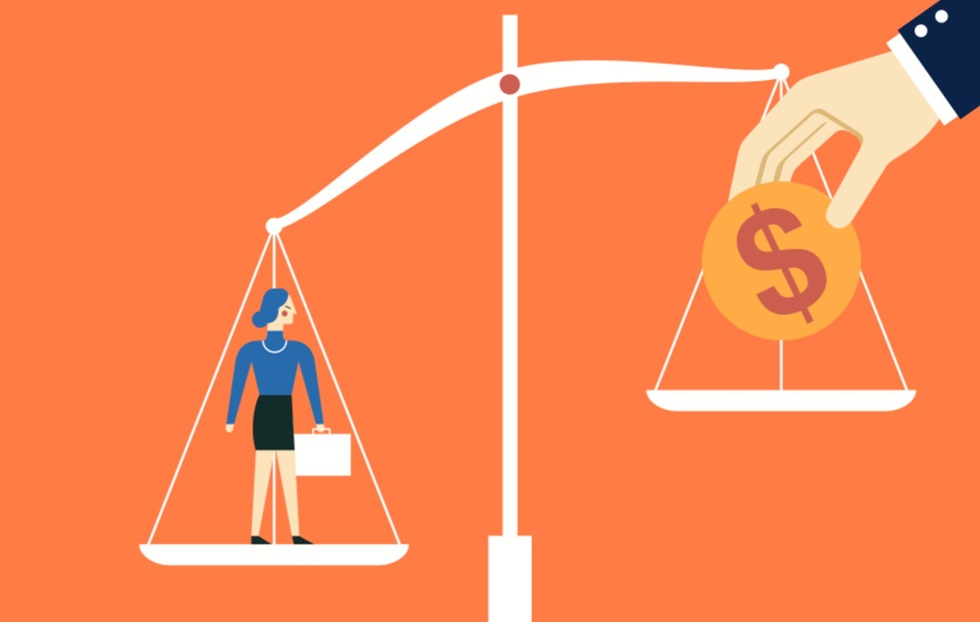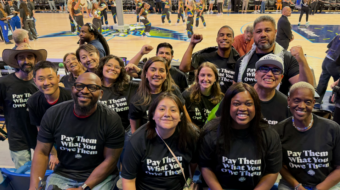
WASHINGTON—This year, the National Women’s Law Center says, Equal Pay Day has special significance for all women, not just working women.
That’s because while April 12 marked the day—a year and 10 weeks after 2022 ended—that a median working woman’s pay for that year reached the median working man’s pay for 2022 alone, the situation could get much worse and the day retreat farther in coming years as red states delete abortion rights.
Women enter the work force at unequal levels compared to men with the same skills and qualifications. They drop further behind as their careers continue. And they really drop behind when they’re forced to drop out to have and raise kids. Abortion bans will force millions to do that, NWLC says.
This year, the pay day fell on March 12. The pay gap was 84 cents per dollar for median wages of a working white man. Include part-timers and it widens to 78 cents per dollar.
Which means, NWLC says, the galloping movement among right-wing-run red states to virtually outlaw abortion and sharply restrict—if not abolish—other reproductive rights is only going to make a bad situation for working women even worse. It declined to say how much worse.
The center also points out one big factor in closing the pay gap, even for working women who choose to have kids: An union contract.
“For most people, deciding if or when to have a child has an enormous impact on economic security—and this has been true long before the fall of Roe,” Clarke Wheeler and Sawyeh Esmaili wrote for the center, referring to the 1973 Roe v Wade Supreme Court ruling that abortion is a constitutional right. The five-justice Republican right-wing court majority nullified Roe in 2022.
“On average, states with abortion restrictions or total bans have lower minimum wages and about half the rate of unionization compared to states where abortion is protected.”
“Having the freedom to decide if and when we have kids and how to care for our loved ones affects our financial well-being, job security, and our ability to work and go to school,” the NWLC explained. “Being denied an abortion increases the amount of debt people and their families are in, as well as the rate of bankruptcies and evictions. Studies also show clear links between access to abortion and higher participation in the workforce, increased earnings, and economic independence for women.
“Overcoming the countless barriers to actually getting abortion care comes with a high cost,” it elaborated. “Abortion is expensive due to deliberately constructed barriers to care.” Even under Roe, there were 1,300 restrictions on abortions, which “forced pregnant people”—including LGBT people—“to travel long distances to clinics, take unpaid leave, and pay out-of-pocket expenses for abortion care, transportation, and child care.
Since the Dobbs decision” overturning Roe, “even more people are forced to travel to access abortion… Working-class people and families” get hurt the most.

The biggest gender wage gaps are in red states, according to data from the National Partnership for Women and Families, the prime outside advocates of equal pay legislation for decades.
The biggest pay gap is in Utah—the woman lags by 40 cents per dollar—displacing longtime “leader” in reverse, Wyoming (35 cents). Ten of the bottom 12 states in the pay gap are deep red: Utah, Wyoming, Louisiana, Idaho, Indiana, Alabama, Texas, West Virginia, Kansas and North Dakota in that order. The exceptions: Swing state Michigan (5th, 32-cent gap) and blue Washington state (tied for 8th with Texas, 30 cents).
The smallest pay gap was in D.C., at 13 cents, and Vermont had the second smallest gap at 15 cents. Both are deep blue. So are seven of the next 11 states with the smallest gaps: Delaware, New Mexico, Maine, New York, Maryland, California and Rhode Island. The third-smallest gap, 18 cents, is in swing state Nevada. The other states: Swing states North Carolina and Arizona, plus Alaska, which is heavily unionized and notably independent in its politics.
AFL-CIO President Liz Shuler, the first woman ever to head the nation’s labor federation, has made closing the pay gap a top cause of her career, first with the Electrical Workers, then as federation Secretary-Treasurer, it’s #2 job, before succeeding the late Richard Trumka.
“On Equal Pay Day, we are reminded of the persistent injustice faced by working women across our nation. It is unacceptable that for the past 20 years the gender wage gap remained largely unchanged as big corporations and the wealthy—along with many Republicans—resisted change. But a new wave of hope and organizing is building in the fight for equality, and the labor movement knows that when working people stand together in a union we have the strength and power to demand equal pay for equal work,” she said.
“The labor movement plays an integral role in fixing the gender wage gap. Women in unions earn 22% more than nonunion women. For women of color, the wage gap is essentially closed when they have a union contract. And it’s better in a union for more than just salary. A union contract also means more protection against harassment, discrimination and other abuses women routinely face on the job, as well as health and safety policies, paid leave, and retirement protections.
“We remain steadfast in our efforts to close the gender pay gap once and for all. This means advocating for policies that promote pay transparency, strengthen anti-discrimination laws and ensure fair wages for all workers. It also means challenging outdated attitudes and norms that perpetuate gender stereotypes and devalue women’s contributions in the workforce.
“Unions are more popular now than they’ve been in generations because they’re the answer in the fight for fairness on the job, paid sick days, child care, equal pay and economic justice for women.”
Eliminate the annual wage gap and an average working woman could pay for 13 more months of child care, or more than a year of tuition and fees at a public university, and all the tuition and fees at a community college, seven more months of premiums for employer-based health insurance, nine months of rent or 64 more weeks of food, the National Partnership says. She could even pay off her student loans in fewer than three years.
We hope you appreciated this article. At People’s World, we believe news and information should be free and accessible to all, but we need your help. Our journalism is free of corporate influence and paywalls because we are totally reader-supported. Only you, our readers and supporters, make this possible. If you enjoy reading People’s World and the stories we bring you, please support our work by donating or becoming a monthly sustainer today. Thank you!










